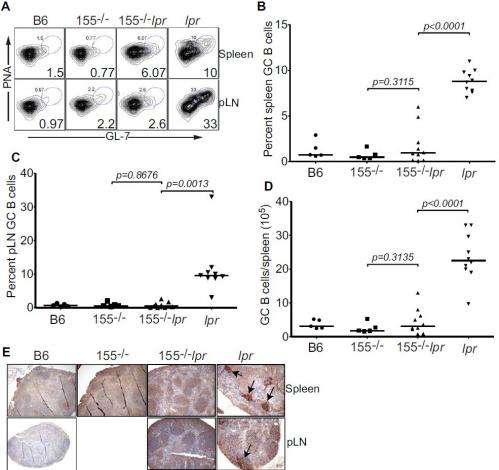December 24, 2013 feature
Molecular mitigation: Deleting microRNA-155 reduces autoimmune response

(Medical Xpress)—While our immune system protects us from myriad bacterial and viral attacks by producing antigen-specific antibodies, this process can sometimes go awry. In such cases, the antibodies target cells and tissues of our own bodies, leading to autoimmunity and a resulting autoimmune disease, examples of which include Type I diabetes, psoriasis and lupus. (Lupus produces antibodies that attack primarily the kidneys.) Recently, scientists at Beth Israel Deaconess Medical Center, Harvard Medical School demonstrated that ablating the regulatory molecule microRNA-155 (also referred to as miR-155), which normally promotes antibody production, prevents harmful antibody production and thereby alleviates lupus-like disease in laboratory mice. The researchers say that their results suggest the possibility of targeting microRNA-155 to treat autoimmune diseases.
Dr. To-Ha Thai discussed the paper that she and her co-authors recently published in Proceedings of the National Academy of Sciences. "MiR-155 regulates systemic autoimmunity in part by controlling the activation threshold of lymphocytes in response to autoantigens," Thai tells Medical Xpress. "In this case, we showed that miR-155 modulates the expression levels of SHIP-1, which is a negative regulator of B-cell receptor activation." (A B-cell receptor, or BCR, is a transmembrane protein located on the outer surface of B cells, which belong to a group of white blood cells known as lymphocytes.) Specifically, the paper shows that the enzyme SHIP-1 is decreased in B cells from lupus-prone mice, resulting in the hyperactivation of these B cells and, in turn, leading to autoantibody overproduction. Deleting miR-155 in lupus-prone mice reverses this increase almost completely, thus dampening autoantibody production and resulting in the amelioration of lupus-like symptoms – for example, fewer double-stranded DNA (dsDNA) autoantibodies and less kidney damage. (Double-stranded DNA, the double helix form in which DNA occurs in chromosomes, is a molecule of DNA consisting of two parallel strands joined by hydrogen bonds between the complementary aromatic heterocyclic organic compounds purines and pyrimidines.)
"MiR-155 regulates the expression levels of SHIP-1, which is a negative regulator of B- receptor activation," Thai continues. "SHIP-1 dampens BCR activation and, therefore, B-cell activation and antibody production. We think that miR-155 is transiently induced upon B-cell activation to control SHIP-1 expression to allow BCR activation to proceed for a finite time." In an autoimmune environment, Thai explains, autoantigens constantly activate B cells to express miR-155 – and this persistent expression of miR-155 results in the sustained repression of SHIP-1, which will eventually lead to the continuous and prolonged activation of autoreactive B cells and thus autoantibody production.
"We think that miR-155 is a good target to treat autoimmune diseases for two reasons," Thai notes. "First, it's only induced when cells are activated, and so will only affect the activated cells that are abundant in autoimmune diseases. Second, we and others find that the deletion of miR-155 only affects the production of autoantibodies – not the more protective natural antibodies – so targeting miR-155 may not pose a danger to an individual, since protective antibody production remains intact."
Moving forward, Thai says, she will attempt to address the confounding findings that they and other investigators have observed – namely, that miR-155 seems to regulate Immunoglobulin G (IgG) and Immunoglobulin M (IgM) antibody responses differentially depending on the type of antigens used. (IgG is the most abundant type of antibody, and is found in all body fluids and protects against bacterial and viral infections. IgM, which is found mainly in the blood and lymph fluid, is the first to be made by the body to fight a new infection.) "More specifically," she adds, "in some studies miR-155 affects both IgG and IgM responses – but in others, it only affects IgG responses. We will continue to further our understanding of this conundrum."
In addition, the researchers will continue to dissect how the adaptive immune response is controlled. "We're looking into the role of other epigenetic modifications in the regulation of the adaptive immune response," Thai tells Medical Xpress. "We would also like to work with industries to develop means to target miR-155 for the treatment of autoimmune diseases."
The other areas of research that might benefit from their study, Thai concludes, are vaccines, immunity, and other autoimmune diseases such as rheumatoid arthritis, cancer, and infection.
More information: Deletion of microRNA-155 reduces autoantibody responses and alleviates lupus-like disease in the Faslpr mouse, PNAS December 10, 2013 vol. 110no. 50 20194-20199, doi:10.1073/pnas.1317632110
© 2013 Medical Xpress. All rights reserved.













